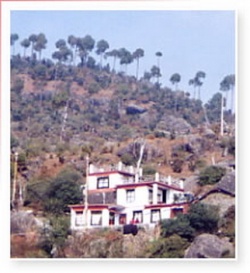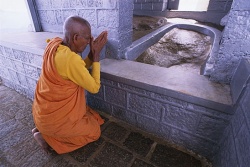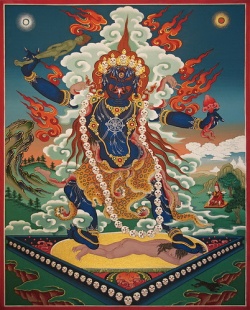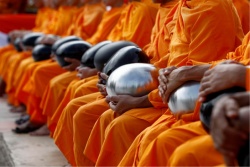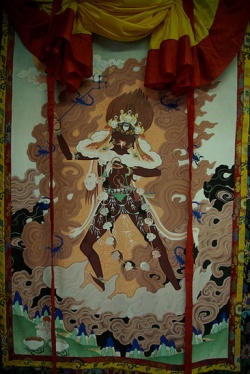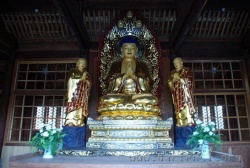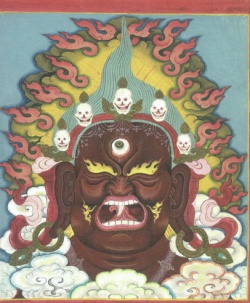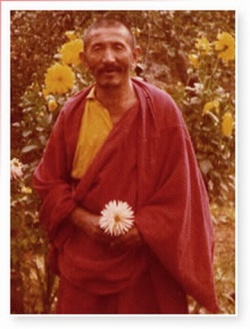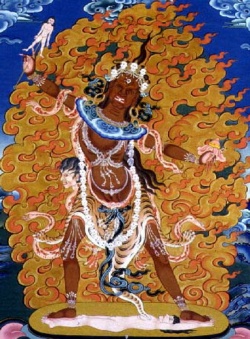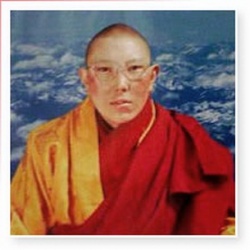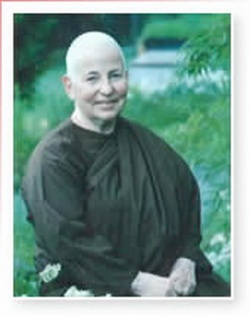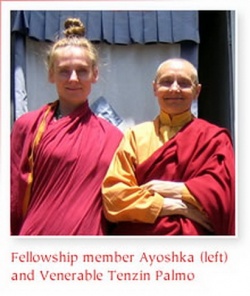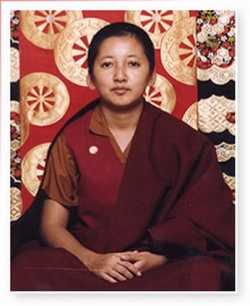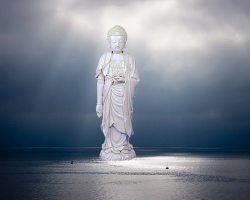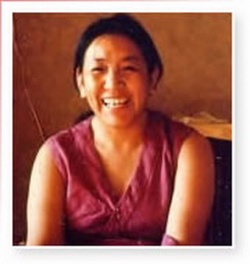Difference between revisions of "Women Buddhas: A Short List of Female Saints, Teachers and Practitioners in Tibetan Buddhism"
| (22 intermediate revisions by 4 users not shown) | |||
| Line 1: | Line 1: | ||
[[File:Pematso.jpg|thumb|250px|]] | [[File:Pematso.jpg|thumb|250px|]] | ||
<poem> | <poem> | ||
| − | [[Venerable]] [[Bhikshuni]] Mahaprajapati Gautama | + | [[Venerable]] [[Bhikshuni]] [[Mahaprajapati Gautama]] |
| + | [[File:Buddhist-monk500.jpg|thumb|250px|]] | ||
| + | [[Venerable Bhikshuni Mahaprajapati Gautama]] was The [[Buddha's aunt]]. When her [[sister]] [[died]] of complications shortly after giving [[birth]] to The [[Buddha]], [[Mahaprajapati]] became his step-mother and raised him herself. | ||
| − | [[ | + | [[File:Ekajat74.jpg|thumb|250px|]] |
| + | Later, after The [[Buddha]] established his [[monastic Order]], [[Mahaprajapati]] asked if she could join and become a [[nun]]. At first The [[Buddha]] did not think that women would be able to [[live]] the [[ascetic life]] that the [[monks]] were following, and in {{Wiki|general}} there were [[doubts]] about the feasibility of women joining what was then an [[order of monks]]. But [[Mahaprajapati]], at the {{Wiki|head}} of a large group of women, persisted, and when she asked a second [[time]], if she and her group of women might establish a parallel [[order of ordained female practitioners]], he agreed. [[Thus]] the [[female Order]] came into being—separate from the {{Wiki|male}} [[Order]] and not under {{Wiki|male}} [[direction]]. This became an [[Order]] of women, exclusively under the control of the women themselves. | ||
| − | + | [[File:Buddhist-monks25.jpg|thumb|250px|]] | |
| + | The [[Buddha's aunt]] therefore not only became the [[first Buddhist nun]] to be [[ordained]] in the [[Buddhist]] {{Wiki|Community}}, but also the [[first head of the women's Order]]. In that [[sense]] she is the founding mother of the [[Buddhist nun]]'s [[order]], just as The [[Buddha]] was the founding [[father]] of the [[Monk]]'s [[order]]. | ||
| + | [[File:Ekajati18374d.jpg|thumb|250px|]] | ||
| − | [[ | + | A certain number of women connected to [[Mahaprajapati]] became leading [[teachers]] of the [[Order of Nun's]]. These formed the first "twelve women {{Wiki|apostles}}", i.e., the first set of [[Bhikshuni]] {{Wiki|saints}}. This set of twelve "[[Foremost]] [[Bhikshunis]]" of the [[Order]] under [[Mahaprajapati]] were: |
| + | [[File:Dacien Temple37.jpg|thumb|250px|]] | ||
| − | + | [[Khema]], foremost [[scholar]] of Great [[Wisdom]]. | |
| − | + | [[Bhadra]] ([[Yasodhara]]), foremost in miraculous [[accomplishment]] ([[mahasiddhi]]). | |
| − | |||
| − | |||
| − | |||
| − | |||
| − | |||
| − | |||
| − | |||
| − | |||
| − | |||
| − | |||
| − | |||
| − | Mahaprajapati achieved complete realization and was known as an [[Arhat]]—an enlightened Saint and the first | + | [[Gautami]], foremost in holiness. |
| − | [[Bodhisattva]] [[Tara]] (Dolma) | + | |
| + | [[Sakula]], foremost in {{Wiki|clairvoyance}}. | ||
| + | |||
| + | Dharmadina, foremost {{Wiki|missionary}} and [[teacher]]. | ||
| + | |||
| + | [[Uppalavanna]], foremost in [[realization]]. | ||
| + | |||
| + | [[Bhadra Kundali]], foremost in [[psychic]] [[faculties]]. | ||
| + | |||
| + | [[Nanda]], foremost of the {{Wiki|Forest}} [[Meditators]]. | ||
| + | |||
| + | [[Bhadra]] [[Kapila]], foremost in remembering past-lives. | ||
| + | |||
| + | [[Patacara]], foremost holder of the [[Vinaya]]. | ||
| + | |||
| + | [[Sigalakamatra]], foremost in "[[attainment]] through [[faith]]'. | ||
| + | |||
| + | [[Sonya]], foremost in [[diligence]]. | ||
| + | |||
| + | [[File:Ekajati21.jpg|thumb|250px|]] | ||
| + | [[Mahaprajapati]] achieved complete [[realization]] and was known as an [[Arhat]]—an [[enlightened Saint]] and the [[first female Buddha]]". Many of her women followers also [[attained]] full [[Enlightenment]] and their [[poetry]] has been preserved in a large collection of writings known as the [[Theri-gata]], or "[[Songs of the Women Elders]]". | ||
| + | |||
| + | [[Bodhisattva]] [[Tara]] ([[Dolma]]) | ||
[[File:Gegenkhyentse.jpg|thumb|250px|]] | [[File:Gegenkhyentse.jpg|thumb|250px|]] | ||
| − | We are told that long ago there was a Princess named [[Tara]] who was very devout. One day, a [[Monk]] who did not believe that women could attain [[Enlightenment]], told her that she should pray to be born in a male [[Body]] in her next life in order to become Enlightened, and thus able to benefit others. Instead, she vowed to attain [[Enlightenment]] as a woman in that very life and thenceforth prayed to always be reborn as a woman. | + | We are told that long ago there was a {{Wiki|Princess}} named [[Tara]] who was very devout. One day, a [[Monk]] who did not believe that women could attain [[Enlightenment]], told her that she should pray to be born in a {{Wiki|male}} [[Body]] in her next [[life]] in [[order]] to become [[Enlightened]], and thus able to {{Wiki|benefit}} others. Instead, she [[vowed]] to attain [[Enlightenment]] as a woman in that very [[life]] and thenceforth prayed to always be [[reborn]] as a woman. |
| + | [[File:Ekajati33.jpg|thumb|250px|]] | ||
| − | Thus [[Tara]] has become a symbol of the fact that any woman can become Enlightened. She represents "Enlightened Womanhood", and stands as a female "Prophet" or "Saviour" among men like Moses, Jesus, Mohammed, and so many others | + | [[Thus]] [[Tara]] has become a [[symbol]] of the fact that any woman can become [[Enlightened]]. She represents "[[Enlightened]] Womanhood", and stands as a {{Wiki|female}} "Prophet" or "Saviour" among men like Moses, {{Wiki|Jesus}}, {{Wiki|Mohammed}}, and so many others. |
| − | + | [[Tara]] is represented in various [[forms]] but most commonly she is white or [[green]] in {{Wiki|color}}. Although [[acknowledged]] to have been an actual living {{Wiki|female}} {{Wiki|saint}}, she has also evolved into something of a "[[Goddess]] of [[Mercy]]", and her {{Wiki|worship}} is very popular throughout the {{Wiki|east}}, in [[Nepal]], [[Tibet]], [[China]] and [[Japan]]. | |
| − | |||
| − | + | The Twenty-one [[forms]] of [[Tara]] is a set of icons, each representing [[Tara]], in reference to an aspect of {{Wiki|female}} [[Buddhahood]] and protecting against a specific type of [[Suffering]]. These remind us of the fact that there have been and have been and continue to be {{Wiki|innumerable}} women [[Buddhas]] throughout {{Wiki|history}} and all over the [[world]].. | |
| + | {{Wiki|Princess}} [[Mandarava]] | ||
| − | + | [[Pema Tso]] [[Women's Monastery]] {{Wiki|Princess}} [[Mandarava]] was born in the eighth century, as the daughter of the [[King]] of [[Zahor]], a small {{Wiki|kingdom}} of {{Wiki|northern India}}, centered around the {{Wiki|capital}} town of Mandi. She refused to be [[married]] and insisted on becoming a [[nun]] instead. When her [[father]] refused to agree, she left and became a {{Wiki|beggar}} and was eventually [[ordained]] by the [[Abbot]] [[Shantarakshita]]. The [[King]] of [[Zahor]] then agreed to accept his daughter's way of [[life]] and built a [[monastery]] for her and her women followers to [[meditate]] in. | |
| − | |||
| − | Princess Sakyadevi was the daughter of King Sukkhadhara of Nepal. Her mother died in childbirth and she was displaced by the next queen and abandoned by the court. When she grew up she became a Yogini and resided near present day Parphing, in the mountains just outside the Kathmandu Valley. There she is said to have become a consort of [[Guru]] [[Padmasambhava]] and received teachings from him. The two lived together at the yogi's cave of Langlesho, above Parphing, where they mastered Vajrakilaya-practice. It is said that she eventually attained "[[Rainbow body]]" as a realized female | + | Today there is a famous lake known as [[Rewalsar]] above the town of Mandi in the [[Himalayas]]. The [[Tibetans]] call this very [[beautiful]] lake [[Pema Tso]]. Circling the lake are many [[Buddhist]] [[monasteries]], [[Hindu]] and {{Wiki|Sikh}} [[temples]], and other [[religious]] establishments. Looking down over [[Rewalsar]], from higher up the mountainside is [[Mandarava's cave}}, where a group of women [[yoginis]] [[live]] in isolated [[retreat]]. These saintly women practice [[meditation]] day and night with great [[diligence]]. [[Thus]] the [[spiritual]] [[tradition]] of [[Mandarava]] [[lives]] on today. |
| − | Princess [[Yeshe Tsogyal]] | + | |
| + | {{Wiki|Princess}} [[Sakyadevi]] | ||
| + | |||
| + | {{Wiki|Princess}} [[Sakyadevi]]]] was the daughter of [[King]] Sukkhadhara of [[Nepal]]. Her mother [[died]] in {{Wiki|childbirth}} and she was displaced by the next {{Wiki|queen}} and abandoned by the court. When she grew up she became a [[Yogini]] and resided near {{Wiki|present}} day [[Parphing]], in the [[mountains]] just outside the {{Wiki|Kathmandu Valley}}. There she is said to have become a [[consort]] of [[Guru]] [[Padmasambhava]] and received teachings from him. The two lived together at the [[yogi's]] {{Wiki|cave}} of Langlesho, above [[Parphing]], where they mastered [[Vajrakilaya-practice]]. It is said that she eventually [[attained]] "[[Rainbow body]]" as a [[realized]] {{female Buddha]]. | ||
| + | {{Wiki|Princess}} [[Yeshe Tsogyal]] | ||
[[File:Khandromapaldenchotso.jpg|thumb|250px|]] | [[File:Khandromapaldenchotso.jpg|thumb|250px|]] | ||
| − | Princess Yeshe TsogyalThe Tibetan Princess [[Yeshe Tsogyal]] was the principle disciple of [[Guru]] [[Padmasambhava]] in Tibet. [[Padmasambhava]] arrived in Tibet in the 8th Century CE, at the invitation of the King [[Trisong Detsen]]. There, he taught [[ | + | {{Wiki|Princess}} Yeshe TsogyalThe [[Tibetan]] {{Wiki|Princess}} [[Yeshe Tsogyal]] was the [[principle]] [[disciple]] of [[Guru]] [[Padmasambhava]] in [[Tibet]]. [[Padmasambhava]] arrived in [[Tibet]] in the 8th Century CE, at the invitation of the [[King]] [[Trisong Detsen]]. There, he [[taught]] The [[Buddha]]'s teachings and built the first [[monastery]] in [[Tibet]]. [[Yeshe Tsogyal]] accomplished complete [[Enlightenment]] and was responsible for preserving the rarest teachings of the [[Dharma]]. |
| − | Kalasiddhi | + | |
| + | |||
| + | [[Kalasiddhi]] | ||
| + | |||
| + | [[Kalasiddhi of Nepal]] was the daughter of weavers from the town of Balbong Jur. Her mother [[died]] in a famine and she was abandoned with her mother's [[Body]] at the [[cremation]] ground. A woman [[Yogini]] (some accounts identify her as [[Mandarava]]) found the baby, saved her from starvation and brought the girl up, ateaching her all her secret practices. Later [[Bhikshu]] [[Sakyadeva]] gave her [[ordination]]. | ||
| + | |||
| + | After [[Kalasiddhi]] [[attained]] [[Enlightenment]], she passed her [[lineage]] to a farmer's son who became the great [[Master]] [[Vajrahunkara]]. | ||
| + | |||
| + | In the [[Terma]] [[tradition]] of [[Terton]] [[Tagsham]], [[Kalasiddhi]] meets and becomes a [[disciple]] of [[Guru]] [[Padmasambhava]] and [[Yeshe Tsogyal]], but this may be a case of mixing stories together, since [[Vajrahunkara]] was himself prior to [[Padmasambhava]], and [[Kalasiddhi]] met and instructed [[Vajrahunkara]] in his youth. At any rate, it is said that at the end of her [[life]] [[Kalasiddhi]] [[attained]] the complete [[Enlightenment of an Insight-holder]] ([[Vidyadhara]]). | ||
| + | |||
| + | |||
| + | [[Lha-cham Pema-Sel]] | ||
| + | |||
| + | [[Lha-cham Pema-Sel]] was the daughter of [[King]] [[Tri-song Detsan]] of [[Tibet]] and {{Wiki|Queen}} [[Dromza Changchub]]. When she was eight years old, [[Lha-cham Pema-Sel]] fell ill and [[died]]. [[Padmasambhava]], who was staying in the {{Wiki|royal}} palace at the [[time]], was called for. He immediately came to the room where her [[Body]] lay and wrote the [[letter]] "Nri" in [[red]] over her [[heart]], while reciting [[mantras]]. Entering into [[trance]], he then recalled her [[consciousness]] and brought [[life]] back into her [[Body]]. This [[miracle]] of {{Wiki|resurrection}} stunned the court and [[caused]] the [[King]] to have [[absolute]] [[faith]] in the [[Guru]]'s saintly [[powers]]. | ||
| − | + | When [[Lha-cham]] had revived and was able to speak, [[Guru]] [[Padmasambhava]] conferred on her the [[empowerments]] of the [[Khadro Nying-t'ig]], a rare line of [[esoteric]] instruction. Later, in a {{Wiki|future}} [[life]] as the {{Wiki|male}} [[yogi]] [[Pema Le-drel Tsal]] (1291-1315), the teachings that [[Padmasambhava]] had given her re-awoke in her [[consciousness]]. Several [[incarnations]] later the same {{Wiki|stream}} of [[consciousness]] took [[birth]] and [[attained]] [[realization]] in the [[form]] of the great [[Nyingma]] {{Wiki|saint}} [[Longchenpa]] (1308-1363). | |
| − | |||
| − | + | [[Yogini]] [[Disciples]] | |
| − | |||
| − | |||
| − | |||
| − | |||
[[File:Ayyakhema.jpg|thumb|250px|]] | [[File:Ayyakhema.jpg|thumb|250px|]] | ||
| − | Amongst the many Yogini Disciples of [[Padmasambhava]] there are listed Rinchen-tsho of the Ma-go family who beheld many spiritual visions, Changchub of the Chogro family who was greatly enlightened, Lha-kar-ma of the Dzin family who would levitate into the air off her meditation cushion, Lhamo Yerab of Ba who healed the sick through her meditations, Dorje Tsho who walked on water, Sherab Phagma who possessed a photographic memory, and Bromti Chenmo of the Dro family who could levitate at will. The numerous women disciples of [[Guru]] [[Padmasambhava]] in Tibet also included the twenty-five realized [[Dakinis]] of Chim-phu and the Seven Great Yoginis. | + | Amongst the many [[Yogini]] [[Disciples]] of [[Padmasambhava]] there are listed Rinchen-tsho of the Ma-go [[family]] who beheld many [[spiritual]] [[visions]], [[Changchub]] of the Chogro [[family]] who was greatly [[enlightened]], Lha-kar-ma of the Dzin [[family]] who would levitate into the [[air]] off her [[meditation]] cushion, [[Lhamo]] Yerab of Ba who healed the sick through her [[meditations]], [[Dorje]] Tsho who walked on [[water]], Sherab Phagma who possessed a {{Wiki|photographic memory}}, and Bromti [[Chenmo]] of the [[Dro]] [[family]] who could levitate at will. The numerous women [[disciples]] of [[Guru]] [[Padmasambhava]] in [[Tibet]] also included the twenty-five [[realized]] [[Dakinis]] of Chim-phu and the Seven Great [[Yoginis]]. |
| − | Jetsunma [[Niguma]] | + | |
| + | |||
| + | [[Jetsunma Niguma]] | ||
| + | |||
| + | [[Jetsunma Niguma]] was born in [[Kashmir]]. The term "[[sister]]" sometimes means a [[family]] [[sister]] and sometimes was used as a {{Wiki|polite}} term for "wife" in {{Wiki|ancient}} times. [[Niguma]] is described as the "[[sister]]" of the [[Mahasiddha]] [[Naropa]]. In some accounts this means she was his [[sister]] literally, but in certain other accounts it appears she may have been his [[consort]]. At any rate, she was a very great [[Yogini]]. Dedicating her [[life]] towards practicing and perfecting The [[Buddha]]'s teachings, she [[manifested]] as a tenth-level [[Bodhisattva]] and directly saw the face of the [[primordial]] [[Buddha]] [[Vajradhara]]. Her foremost [[disciple]] was [[Khyungpo Naljor]], who brought [[Niguma]]'s teachings to [[Tibet]] and established the [[Shangpa Kagyu lineage]], one of the eight [[transmission]] [[lineages]] of [[Tibet]]. | ||
| + | |||
| − | |||
[[Dakini]] [[Sukhasiddhi]] | [[Dakini]] [[Sukhasiddhi]] | ||
| − | [[Dakini]] [[Sukhasiddhi]] was a laywoman with a husband and six children. However, her family chased her out of the house when she gave their last store of rice to a starving beggar. After wandering for some time, she met a Yogi in the lineage of the [[Mahasiddha]] Virupa, who bestowed [[Empowerment]] and [[ | + | [[Dakini]] [[Sukhasiddhi]] was a [[laywoman]] with a husband and six children. However, her [[family]] chased her out of the house when she gave their last [[store]] of {{Wiki|rice}} to a starving {{Wiki|beggar}}. After wandering for some [[time]], she met a [[Yogi]] in the [[lineage]] of the [[Mahasiddha]] [[Virupa]], who bestowed [[Empowerment]] and The [[Buddha]]'s teachings on her. She was a [[master]] of [[Hevajra Tantra]]. [[Sukhasiddhi]] accomplished complete [[Enlightenment]] and became one of the [[teachers]] of [[Tilopa]]. |
| − | [[Bhikshuni]] Srimati | + | [ |
| + | |||
| + | [[Bhikshuni]] [[Srimati]] | ||
| + | |||
| + | |||
| + | [[Bhikshuni Srimati]] (Tib: [[Gelongma Palmo]]) was an [[ordained]] [[Buddhist nun]] in [[India]] who founded the [[Avalokitesvara]] "[[Nyun-gne]]" [[tradition]]. This [[tradition]] involves [[fasting]] and all-night vigils, with [[prayers]] to the One-Thousand [[Form]] of the Great [[Bodhisattva]] of [[Compassion]], [[Avalokitesvara]] (Tib: [[Chenrezi]], {{Wiki|Chinese}}: [[Kwan-yin]]). [[Bhikshuni] Srimati]] was born into a {{Wiki|royal}} [[family]], but she refused to be forced into [[marriage]], wanting instead to become [[ordained]] and practice the [[Dharma]]. She left her [[family]] and became a [[Bhikshuni]]. | ||
| + | |||
| + | After contracting {{Wiki|leprosy}}, an {{Wiki|illness}} which is widely feared in [[India]], she was cast out of her [[religious]] {{Wiki|community}} and had to [[live]] in the {{Wiki|forest}}. The great [[Mahasiddha]] [[Indrabodhi]] came across her and instructed her in [[devotion]] to [[Avalokitesvara]]. Through [[meditation]] and [[prayer]], her {{Wiki|leprosy}} disappeared and she was entirely cured. Sometime after that she [[attained]] [[Enlightenment]] and eventually acquired many [[disciples]]. | ||
| + | |||
| + | |||
| + | [[Machig Lhab-Dron]] | ||
| + | |||
| + | |||
| + | The [[Tibetan]] [[Kagyu]] [[yogini]] [[Machig Lhab-Dron]] (1055-1152) founded the {{Wiki|female}} [[lineage of Chöd Practice]] in [[Tibet]] and was an exponent of the [[Prajnaparamita Sutra]]. She was the [[disciple]] of the [[Indian]] [[Guru]] [[Pha Dampa Sanggye]]. She is the only [[Tibetan]], {{Wiki|male}} or {{Wiki|female}}, to found a [[lineage]] of [[spiritual]] practice that came to be transmitted from [[Tibet]] to [[India]], rather than from [[India]] to [[Tibet]]. [[Chöd]] is a {{Wiki|powerful}} practice which involves "cutting through the [[ego]]." This practice {{Wiki|remains}} popular throughout [[Tibet]], [[Mongolia]] and the [[Indian]] [[Himalayas]] up to the {{Wiki|present}} day. | ||
| + | |||
| + | |||
| − | [[ | + | Women [[Disciples]] of [[Milarepa]] |
| − | |||
| − | |||
| − | |||
[[File:Tenzinpalmo.jpg|thumb|250px|]] | [[File:Tenzinpalmo.jpg|thumb|250px|]] | ||
| − | Some of the famous female disciples of the 11th century [[Kagyu]] yogi [[Milarepa]] were: | + | Some of the famous {{Wiki|female}} [[disciples]] of the 11th century [[Kagyu]] [[yogi]] [[Milarepa]] were: |
| + | |||
| + | [[Rechungma]] doubted [[Milarepa]]'s [[realization]] upon their first meeting, but she later gained complete [[faith]] in him. [[Milarepa]] imparted to [[Rechungma]] all the [[pith-instructions]] without reserve. She practiced in complete [[silence]] for eight years and [[attained]] [[Enlightenment]] through the practice of [[gTum-mo]]. At the [[time]] of her passing, she had become a leading exponent of [[Milarepa]]'s teachings. | ||
| + | |||
| + | [[Padarbum]] similarly achieved complete [[Enlightenment]] in a single [[lifetime]]. After first scorning and belittling [[Milarepa]] upon their encounter, she was converted to the [[Dharma]] by his [[beautiful]] songs. [[Padarbum]] succeeded be able to enter into higher {{Wiki|dimensions}} while in her [[human]] [[Body]]. Playing a [[drum]] for all to hear, at the [[time]] of her [[death]] she is said to have [[bodily]] vanished, ascending into the [[pure realm]] of the [[Dakinis]]. | ||
| + | |||
| + | [[Sahle Aui]] [[meditated]] in [[solitude]] for many years, achieving [[Enlightenment]]. She later [[taught]] the [[Dharma]] to many [[disciples]] throughout [[Tibet]]. | ||
| − | + | [[Tseringma]], tamed by [[Jetsun Milarepa]], became a [[tenth-level Bodhisattva]]. She is now frequently prayed to as a {{Wiki|holy}} [[protector of the Dharma]]. | |
| − | + | These are just a few of [[Milarepa]]'s {{Wiki|female}} [[disciples]]. | |
| − | |||
| − | + | [[Jomo Menmo]] | |
| − | |||
| − | |||
| − | Jomo Menmo (1248-1283) was born as a karmic emanation of [[Yeshe Tsogyal]]. She was the wife of [[Guru Chowang]], one of the five Master Tertons of Tibet. Jomo Menmo herself discovered Treasure-texts ([[Terma]]) when she was a teenager and hid many of these treasure teachings throughout Tibet. She passed away by dissolving into the sky, along with two female disciples. | + | [[Jomo Menmo]] (1248-1283) was born as a [[karmic]] [[emanation]] of [[Yeshe Tsogyal]]. She was the wife of [[Guru Chowang]], one of the five [[Master]] [[Tertons]] of [[Tibet]]. [[Jomo Menmo]] herself discovered [[Treasure-texts]] ([[Terma]]) when she was a teenager and hid many of these [[treasure]] teachings throughout [[Tibet]]. She passed away by dissolving into the sky, along with two {{Wiki|female}} [[disciples]]. |
| − | |||
| − | |||
| − | When the Mongols invaded Tibet in the 18th Century, Mindrolling monastery was sacked. Jetsunma and her younger brother Rinchen Namgyal fled to Sikkim. When they returned to Tibet, Jetsunma rebuilt the monastery of Mindrolling from the ground up. She transmitted the entire cycle of empowerments to the monks and Lamas newly installed there. She also founded Samten Tse Nunnery, where she spent most of her later life, writing commentaries and giving teachings. | + | [[Jetsunma Mingyur Paldron]] |
| − | Jetsunma Thinley Chodron | + | |
| + | |||
| + | [[Jetsunma Mingyur Paldron]] (1699-1769) was the daughter of the [[Terton]] [[Terdak Lingpa]]. [[Terdak Lingpa]] founded [[Mindrolling Monastery]], which is the main seat of the [[Nyingmapa]] school. By the [[time]] she was fourteen, [[Jetsunma]] had fully mastered the practice of [[gTum-mo]] ([[kundalini]]) and she received from many different [[Lamas]] the complete [[transmission]] for a great number of teachings. She became an accomplished [[Lama]] in both the [[Kagyu]] and [[Nyingma]] [[traditions]] of [[Tibetan Buddhism]]. In particular, from [[masters]] such as [[Lochen Dharmashri]], [[Kathok]] [[Rigdzin Shabdrung]] and other [[masters]] she was given the title of Lineage-holder. | ||
| + | |||
| + | When the {{Wiki|Mongols}} invaded [[Tibet]] in the 18th Century, [[Mindrolling monastery]] was sacked. [[Jetsunma]] and her younger brother [[Rinchen Namgyal]] fled to [[Sikkim]]. When they returned to [[Tibet]], [[Jetsunma]] rebuilt the [[monastery]] of [[Mindrolling]] from the ground up. She transmitted the entire cycle of [[empowerments]] to the [[monks]] and [[Lamas]] newly installed there. She also founded [[Samten]] Tse [[Nunnery]], where she spent most of her later [[life]], [[writing]] commentaries and giving teachings. | ||
| + | [[Jetsunma]] Thinley Chodron | ||
[[File:Khandrorinpoche.jpg|thumb|250px|]] | [[File:Khandrorinpoche.jpg|thumb|250px|]] | ||
| − | Jetsunma Thinley Chodron was one of the root lamas to [[Jamyang Khyentse Wangpo]]. She was the daughter of 5th [[Mindrolling Trichen]] Thinley Namgyal. She was an ordained nun, and studied under many great masters. She eventually became greatly accomplished in Dzogchen. She also taught widely throughout Tibet and had many disciples. | + | [[Jetsunma]] Thinley Chodron was one of the [[root]] [[lamas]] to [[Jamyang Khyentse Wangpo]]. She was the daughter of 5th [[Mindrolling Trichen]] Thinley [[Namgyal]]. She was an [[ordained]] [[nun]], and studied under many great [[masters]]. She eventually became greatly accomplished in [[Dzogchen]]. She also [[taught]] widely throughout [[Tibet]] and had many [[disciples]]. |
| − | Jetsunma Shukseb | + | [[Jetsunma]] Shukseb |
| + | |||
| + | The [[Tibetan]] girl [[Ani]] [[Lochen]], renowned as [[Jetsunma]] Shukseb, (1865-1951) was a woman [[master]] of [[Chöd]]. She was born in [[Rewalsar]], [[India]], and her [[connection]] was mainly to the [[Drukpa]] [[Kagyu]] and [[Nyingma]] [[lineages]]. From childhood, [[Jetsunma]] Shukseb was a diligent [[practitioner]]. Her mother was also a devoted [[practitioner]], who accompanied her daughter on many [[pilgrimages]] and encouraged her practice. When she visited {{Wiki|Ladakh}} as a little girl, the [[King]] and everyone wept in {{Wiki|tears}} after [[seeing]] [[Jetsunma]] Shukseb reciting [[mantras]], her [[visible]] [[devotion]] was so great! | ||
| + | |||
| + | [[Jetsunma]] Shukseb took [[Lama]] [[Pema Gyatso]] as her [[root]] [[Guru]]. Under his guidance she became a [[practitioner]] of [[Terma]] and [[Chöd]]. In the 1890s she finally received [[ordination]] as a [[nun]], but still kept her [[hair]] long. [[Jetsunma]] Shukseb went on many [[pilgrimages]] with her [[Lama]] and also visited many of [[Tibet's]] greatest [[monasteries]]. | ||
| + | |||
| + | She founded the Shukseb [[Nunnery]], which is {{Wiki|east}} of {{Wiki|Lhasa}}. There she encouraged the women to become [[ordained]]. Many [[masters]] such as [[Reting Rinpoche]], the [[16th Gyalwa Karmapa]], [[Trulshik Rinpoche]] and the [[Shechen Rabjam]] came to visit her. | ||
| − | + | [[Jetsunma]] Shukseb was known as a living [[Mahasiddha]], a [[miracle]] working {{Wiki|saint}}, who was accomplished in [[Dzogchen]] and [[Mahamudra]]. Her [[nunnery]] was destroyed during the {{Wiki|Communist}} {{Wiki|Cultural Revolution}} but is slowly [[being]] rebuilt. | |
| + | [[Sera]] [[Khandro]] | ||
| − | + | [[Sera]] [[Khandro]] (1899-1952) was a great {{Wiki|female}} [[Terton]] whose [[treasure texts]] are revered by many great [[Nyingma]] [[masters]]. She was the wife of Drimey Ozer, one of the sons of the illustrious [[Dudjom Lingpa]]. She was also one of the [[root]] [[gurus]] to the great [[Chatral Rinpoche]] who [[lives]] at [[Parphing]] in [[Nepal]]. | |
| + | [[Khandro]] [[Urgyen]] Tsomo | ||
| − | + | [[Khandro]] [[Urgyen]] Tsomo was the [[consort]] to the 15th [[Gyalwa]] [[Karmapa]] and an [[incarnation]] of [[Yeshe Tsogyal]]. Through her practices and [[recitations]] of [[mantra]], the [[Gyalwa]] [[Karmapa]] was healed of {{Wiki|illness}} and his [[life]] was prolonged. After the [[Karmapa]]'s passing away, she remained at [[Tsurphu]] [[Monastery]] in [[retreat]] and instructed others in the [[Dharma]]. She became renowned as the Great [[Dakini]] of [[Tsurphu]]. The [[16th Gyalwa Karmapa]] gave [[Khandro]] [[Urgyen]] Tsomo's hand [[drum]] as a [[sacred]] momento into the [[care]] of the women [[Lama]], [[Karma]] Chanchub [[Tashi]] [[Drolma]]. | |
| + | [[Jetsunma]] [[Tsewang Lhamo]] | ||
| − | Jetsunma | + | [[Jetsunma]] [[Tsewang Lhamo]] passed away in 1995, remaining in the [[state]] of [[Samadhi]] for three days. She was the daughter of Tritsab [[Pema Wangchen]] and the grand aunt of the {{Wiki|present}} [[Mindrolling Trichen]]. [[Jetsun]] [[Tsewang]] [[Lhamo's]] [[root]] [[Guru]] was [[Jampal]] Dewai [[Nyima]] from whom she took her [[ordination]] [[vows]] and received instruction. [[Jetsunma]] also received profound teachings from [[Khenchen]] [[Khyentse Norbu]] and [[Chung]] [[Rinpoche]]. After the {{Wiki|Cultural Revolution}}, [[Jetsunma]] lived with [[Chung]] [[Rinpoche]] until he passed away in 1979. In 1982, [[Jetsunma]] left [[Tibet]] for [[Mindrolling monastery]] in [[India]], with her younger [[sister]] [[Jetsun]] [[Dechen Wangmo]] and her grandnephew, [[Khenchen]] [[Khenrab]] Gyatso, the {{Wiki|present}} [[Mindrolling]] [[Khenchen]]. |
| − | + | Ven. [[Khandroma]] [[Palden]] Chotso | |
| − | + | Ven. [[Khandroma]] [[Palden]] ChotsoVen. [[Khandroma]] [[Palden]] Chotso: "[[Dakini]] [[Hermitage]]," as it is commonly called, or the "[[Retreat]] [[Center]] of Great Radiance and Expanse at Kilung, in [[Dzachukha]]' ([[Rdza ki lung mkha' 'gro'i 'od gsal klung dbyings sgrub sde]]), is a special [[nunnery]] of women [[Yoginis]] located on a mountain in eastern [[Tibet]]. The [[Hermitage]] is run by Ven. [[Khandroma]] [[Palden Chotso]], daughter of [[Lama]] [[Longtok Rinpoche]] (1922-2001), who was a great [[Dzogchen practitioner]] and a [[Terton]] ([[discoverer of hidden revelations]]) in the [[Longchen Nying-t'ik lineage]] of [[The Nyingma Tradition]]. [[Lama Longtok Rinpoche]] had a large number of students from five [[monasteries]] (the Gegong, Kilung, Gemong, [[Sakya]] and Gyangma [[monasteries]], all in [[Dzachukha]]) who regarded him as their [[root]] [[Lama]]. | |
| − | + | [[File:Url-4.jgfpg.jpg|thumb|250px|]] | |
| + | At the age of five [[Khandroma]] [[Palden Chotso]] was [[ordained]] as a [[novice]] and studied the [[Dharma]] under her [[father]], who was both her [[parent]] and [[root]] [[Lama]]. As she matured, she showed great proficiency in [[tantric yoga practice]]. After [[attaining]] full [[realization]] into the [[nature of mind]], she was given the title of "[[Dakini]]" or "[[Khandroma]]" in [[Tibetan]]. The title is given to a woman who, possessing the qualities of [[Enlightenment]], has the [[duty]] of protecting the [[tantric teachings]]. | ||
| − | + | [[Khandroma]] [[Palden Chotso]] is now resident at the [[Dakini]] [[Hermitage]] in [[Tibet]] with four [[nuns]] who are her [[disciples]]. | |
| − | |||
| − | + | In 2004, [[Khandroma]] [[Palden Chotso]] had a small road built, leading to the [[Hermitage]] to make access up the mountain easier. She also began [[to construct]] an assembly hall so that [[monks and nuns]] who used to be the students of [[Lama]] Longtok's could pray and perform [[rituals]] together. Another [[objective]] of the assembly hall is to house [[Buddha]] images and [[relics]], important [[Buddhist texts]] and other [[treasures]] belonging to her late [[father]]. These [[sacred]] [[objects]] carry the [[blessings]] of many important [[lamas]] in [[Tibet]] and [[India]], and thus are valuable for accumulating [[spiritual]] grace. | |
| − | |||
| − | + | Apart from building the assembly hall, [[Khandroma]] [[Palden Chotso]] also begun to renovate the six [[existing]] cubicles and [[to build]] more so that the number totals thirty. These cubicles will be important living places for [[nuns]] who used to be [[Lama Longtok's]] students and who have scattered to many places after their [[Lama]] passed away. The cubicles will also be used for housing {{Wiki|nomad}} women who would not have the opportunity to practice the [[Dharma]] otherwise. | |
| − | |||
| − | |||
| − | + | After [[Lama Longtok's]] [[death]], the [[nuns]] who used to practice the [[Dharma]] there became "[[Lama]]-less". They scattered and went to practice with other [[lamas]]. At that [[time]] [[Khandroma]] [[Palden Chotso]] was very young and therefore not able to prevent the dispersal. However, she promised her late [[father]] that she would take very good [[care]] of the [[Hermitage]] and that she would become a [[teacher]] of women [[yoginis]]. This promise was made not only as a daughter to her [[father]], but also as a [[student]] to her [[root Lama]], so she regarded this promise to be the most important thing in her [[life]]. She now has become a source of tremendous inspiration for women in [[Tibet]] and for her [[nuns]] in particular. | |
| − | |||
| − | |||
[[Khandro Rinpoche]] | [[Khandro Rinpoche]] | ||
| − | |||
| − | [[Khandro Rinpoche]], as she is commonly called, studied under many learned teachers and received numerous transmissions within both the old and new traditions. Besides studying from various learned Khenpos, she also received teachings and transmissions from some of the most accomplished spiritual masters of recent times, such as her father [[Mindrolling Trichen]], [[Dilgo Khyentse Rinpoche]], Trulzhig [[Rinpoche]], the [[Kagyu]] master [[Tenga Rinpoche]], Tsetrul [[Rinpoche]], and the greatly realized [[Tulku]] Ugyen [[Rinpoche]]. | + | [[Khandroma Tsering Paldron Rinpoche]] is the daughter of [[His Holiness]] [[Mindrolling Trichen]], the {{Wiki|head}} of the [[Nyingma school]] of [[Tibetan Buddhism]]. She was born in {{Wiki|Kalimpong}}, [[India]], in 1967. At the age of two she was [[recognized]] by [[His Holiness]] the [[16th Karmapa]] as the [[reincarnation]] of the Great [[Dakini of Tsurphu]], [[Khandro]] [[Urgyen Tsomo]]. [[Thus]], the {{Wiki|present}} [[Khandro Rinpoche]] came to hold the [[lineages]] of both the unexcelled [[Kagyu]] school and the {{Wiki|ancient}} [[Nyingmapa]]. |
| + | |||
| + | [[Khandro Rinpoche]], as she is commonly called, studied under many learned [[teachers]] and received numerous [[transmissions]] within both the old and new [[traditions]]. Besides studying from various learned [[Khenpos]], she also received teachings and [[transmissions]] from some of the most accomplished [[spiritual]] [[masters]] of recent times, such as her [[father]] [[Mindrolling Trichen]], [[Dilgo Khyentse Rinpoche]], Trulzhig [[Rinpoche]], the [[Kagyu]] [[master]] [[Tenga Rinpoche]], Tsetrul [[Rinpoche]], and the greatly [[realized]] [[Tulku]] [[Ugyen]] [[Rinpoche]]. | ||
[[File:Jetsunkushok.jpg|thumb|250px|]] | [[File:Jetsunkushok.jpg|thumb|250px|]] | ||
| − | [[Khandro Rinpoche]], at 35 years of age, has established and is head of the Samten Tse Retreat Centre in India, which is for Tibetan nuns as well as western practitioners. Her efforts at Samten Tse are directed towards fulfilling her vision of providing a place of study and retreat for women, as well as establishing a spiritual community of both monastics and lay-practitioners with students from both East and West living together. [[Khandro Rinpoche]] also leads various charitable projects for health care and education in remote areas, and the Dharmashri Journal, besides being very actively involved with the Mindrolling monastery in India. More information and pictures of [[Khandro Rinpoche]] may be viewed on her website, www.vkr.org. | + | [[Khandro Rinpoche]], at 35 years of age, has established and is {{Wiki|head}} of the [[Samten]] Tse [[Retreat]] Centre in [[India]], which is for [[Tibetan]] [[nuns]] as well as {{Wiki|western}} practitioners. Her efforts at [[Samten]] Tse are directed towards fulfilling her [[vision]] of providing a place of study and [[retreat]] for women, as well as establishing a [[spiritual]] {{Wiki|community}} of both [[monastics]] and lay-practitioners with students from both {{Wiki|East}} and {{Wiki|West}} living together. [[Khandro Rinpoche]] also leads various charitable projects for [[health]] [[care]] and [[education]] in remote areas, and the [[Dharmashri]] Journal, besides [[being]] very actively involved with the [[Mindrolling monastery]] in [[India]]. More [[information]] and pictures of [[Khandro Rinpoche]] may be viewed on her website, www.vkr.org. |
| + | |||
| + | [[Khandro Rinpoche]] is one of the leading saintly women of the [[Buddhist]] [[world]] in {{Wiki|present}} times. | ||
| + | |||
| + | |||
| + | |||
| + | [[Khandro]] [[Tinley Chodon]] | ||
| − | [[Khandro | + | [[Khandro Tinley Chodon]] and friend trained since childhood in the [[Drukpa Kagyu] tradition]] of [[Buddhism]]. Her great grandfather, the [[Kagyu [Master]] [[Shakyasri]], was a fully [[realized]] [[master]] in [[Dzogchen]]-[[Mahamudra]], and renowned for [[teaching]] the [[highest]] levels of [[Vajrayana practice]]. |
| − | |||
| − | + | Her [[father]] [[Apho Yeshe Rangdrol]] [[Rinpoche]] was responsible for strongly reviving the [[Drukpa Kagyu tradition]] in [[Lahoul]], {{Wiki|Ladakh}}, {{Wiki|Manali}}, {{Wiki|Zanskar}} and Pangey, where he established many [[retreat]] centers, enabling a great number of practitioners to develop their [[spiritual]] practices. He passed away at the age of 54 in 1974, leaving his wife and 4 young children behind. Of his three sons, all [[reincarnations]], his eldest son Sey [[Gelek]] [[Namgyal Rinpoche]] continues the [[Shakyasri]] [[tradition]] at their seat in {{Wiki|Manali}}. | |
| − | + | [[Khandro-la's]] mother [[Sangyum Urgyen Chodon]] was an accomplished [[tantric yogini]]. | |
| − | Khandro-la | + | [[Khandro-la]] was trained under the late [[Gegen Khyentse Rinpoche]], a [[master]] of the [[Six Yogas of Naropa]] and [[Mahamudra]]. She received from him all the [[empowerments]], [[transmissions]] and teachings of her [[lineage]]. [[Khandro-la]] also studied with the late [[Dilgo Khyentse Rinpoche]]. She has also practiced in [[solitary retreat]] under the guidance of the late [[Sengdrak Rinpoche]], known for his humbleness and [[ascetic]] practices in the [[mountains]] of [[Nepal]]. [[Khandro-la]] earned her B.A. in [[Psychology]] at [[Punjab University]], Chandigarh, 1986, and has M.A. in East-West [[Psychology]] from the {{Wiki|California Institute of Integral Studies}}, [[San Francisco]], 1998. |
| − | + | [[Gegen Khyentse Rinpoche]] | |
| − | + | Under the [[direction]] of her [[Lama]], [[Gegen Khyentse]], [[Khandro]] [[Tinley Chodon]] took to guiding [[nuns]] and [[laywomen]] in their practice. She was instrumental in helping [[Tsultrim Allione]] with her [[book]] Women of [[Wisdom]]. She continues to support many [[Buddhist]] women in their [[spiritual]] {{Wiki|training}}. | |
[[File:Url-gh.jpg|thumb|250px|]] | [[File:Url-gh.jpg|thumb|250px|]] | ||
| − | Khandro-la now has a project of her own called Khachodling, dedicated to the education and spiritual [[Empowerment]] of young girls and women seeking spiritual [[Enlightenment]], beginning with twenty-one nuns in Zanskar, Ladakh. Zanskar is renowned for its spectacular landscape and the ancient pilgrimage site of the great [[Mahasiddha]] [[Naropa]] of the 12th century. | + | [[Khandro-la]] now has a project of her [[own]] called [[Khachodling]], dedicated to the [[education]] and [[spiritual]] [[Empowerment]] of young girls and women seeking [[spiritual]] [[Enlightenment]], beginning with twenty-one [[nuns]] in {{Wiki|Zanskar}}, {{Wiki|Ladakh}}. {{Wiki|Zanskar}} is renowned for its spectacular landscape and the {{Wiki|ancient}} [[pilgrimage]] site of the great [[Mahasiddha]] [[Naropa]] of the 12th century. |
| − | [[Ayya]] Khema | + | |
| + | |||
| + | [[Ayya Khema]] | ||
| + | |||
| + | [[Ayya Khema]] was born in {{Wiki|Berlin}} in 1923 to {{Wiki|Jewish}} [[parents]]. In 1938, she was evacuated from {{Wiki|Germany}} with several hundred other children, and taken to [[Glasgow]], {{Wiki|Scotland}}. Her [[parents]] managed to escape to [[China]] and, two years later [[Ayya] Khema]] joined them in [[Shanghai]]. With the outbreak of the [[war]], however, the [[family]] was rounded up by the {{Wiki|Japanese}} and held in a prisoner-of-war camp. It was there that her [[father]] [[died]]. | ||
| + | |||
| + | Four years after the [[American]] [[liberation]] of the camp, [[Ayya Khema]] was able to emigrate to the [[United States]]. She [[married]], had a son and a daughter, and between 1960 and 1964 led a peripatetic [[life]], traveling with her husband and son throughout {{Wiki|Mexico}}, the Amazon and {{Wiki|Asia}}. | ||
| + | |||
| + | While in the [[Himalayas]] she came across [[Buddhism]] and learned [[meditation]]. Her [[experiences]] led her to become a [[Buddhist nun]] in [[Sri Lanka]] in 1979, where she was given the [[name]] "[[Khema]]", meaning safety and {{Wiki|security}}. | ||
| + | |||
| + | [[Ayya Khema]] In {{Wiki|Colombo}}, she set up the [[International Buddhist Women's Centre]] as a {{Wiki|training}} centre for [[Sri Lankan]] [[nuns]], and the [[Parappuduwa Nun's Island]] at Dodanduwa. She was the [[spiritual]] director of [[Buddha-Haus]] in {{Wiki|Germany}}, established in 1989 under her {{Wiki|auspices}}. In June 1997, [[Metta Vihara]], a [[Buddhist]] [[forest monastery]] in {{Wiki|Germany}}, was inaugurated by her, and [[ordinations]] in the {{Wiki|German}} [[language]] have taken place there. | ||
| + | |||
| + | In 1987, she co-ordinated the first international conference of [[Buddhist]] [[nuns]] in [[The History of Buddhism]], which resulted in the setting-up of [[Sakyadhita]], a world-wide [[Buddhist]] women's [[organization]]. H.H. the [[Dalai Lama]] has been a keynote speaker at [[Sakyadhita]] conferences. In May 1987, as an invited lecturer, she was the first ever [[Buddhist nun]] to address the United Nations in {{Wiki|New York}} on the topic of [[Buddhism]] and [[World]] [[Peace]]. | ||
| − | [[Ayya]] | + | [[Ayya Khema]] has written twenty-five [[Books]] on [[meditation]] and The [[Buddha]]'s teachings in {{Wiki|English}} and {{Wiki|German}}; her [[Books]] have been translated into seven [[languages]]. |
| − | + | [[Ayya Khema]] [[died]] November 2, 1997 at [[Buddha Haus]], Mittleberg Uttenbull in {{Wiki|Germany}}. Her work continues through her many students, who have in turn become [[teachers]] in their [[own]] right. A few of the great women who continue her [[lineage]] include Ven. [[Sister]] [[Sangamitta]] from {{Wiki|Switzerland}} (now practising in [[Thailand]]), Ven. [[Sister]] Dhammadina (a graduate of [[Peradeniya University]], Ven. [[Sister Vayama]] from [[Australia]] and Ven. [[Sister Uttpalvanna]] from {{Wiki|Galle}}, [[Sri Lanka]]. | |
| − | |||
| − | [[ | + | [[Tenzin Palmo]], the great [[Yogini]] |
| − | + | [[Tenzin Palmo]], [[Venerable Tenzin Palmo]] was born in [[England]]. She grew up in {{Wiki|London}} and when still only a teen she became a [[Buddhist]]. In 1964, at the age of twenty, she went to [[India]], in pursuit of her [[spiritual]] [[path]]. As a young women in [[India]] she fully immersed herself in the {{Wiki|culture}} and shared [[experiences]] with many [[spiritual]] seekers. | |
| − | [[ | + | In the [[Himalayas]] she met her [[Guru]], [[His Eminence]] the 8th [[Khamtrul Rinpoche]], a famous [[yogi]] of the [[Drukpa]] [[Kagyu]] school. She then took [[ordination]] as a [[Buddhist nun]]. For six years she lived and studied in [[Khamtrul Rinpoche]]'s {{Wiki|community}}. Finally, once she was ready, her [[Lama]] directed her to the [[Himalayan]] valley of {{Wiki|Lahaul}}, in [[order]] to undertake intensive practice. [[Tenzin Palmo]] at first resided in a small [[monastery]] in {{Wiki|Lahaul}}, where she lived in [[retreat]] for many years. Later she moved into a nearby {{Wiki|cave}} high in the [[mountains]], where she was able to [[live]] alone in {{Wiki|nature}} for another 12 years, the last 3 years in strict isolation. A [[book]], titled {{Wiki|Cave}} in the Snow by Vicki Mackenzie, has been written about some of her [[experiences]]. Having gained [[realization]], she left [[India]] in 1988, and went to stay in {{Wiki|Italy}} where she [[taught]] at various [[Dharma]] Centres. |
| − | [[ | + | Before H.E. [[Khamtrul Rinpoche]] passed away in 1980, he had on several occasions requested [[Tenzin Palmo]] to start a convent for women [[yoginis]]. In 1993, the [[Lamas]] of the [[Khampagar monastery]] in [[Himachal Pradesh]] [[India]] again made this request. [[Tenzin Palmo]] began slowly collecting funds for this formidable task. In 1999, she established [[Dongyu Gatsal Ling]] [[Nunnery]] in the [[Himalayas]], where she continues to [[live]] and teach. For more [[information]] about [[Tenzin Palmo]] and the [[Dongyu Gatsal Ling]] [[Nunnery]], please see tenzinpalmo.com. |
| − | [[Tenzin Palmo]], | ||
| − | |||
| − | + | [[Jetsun Kushok Chimey Luding]] [[Rinpoche]] | |
| − | |||
| − | |||
| − | Jetsun Kushok Chimey Luding RinpocheBorn in 1938 as the sister of the current head of the Sakya lineage, one of the four main sects of [[Tibetan Buddhism]], Jetsun Kushok received much of her training alongside her brother. Devoting herself to Buddhist practice from an early age, she completed her first retreat at age 10. Many more important retreats were to follow, enabling her to become one of fewer than a dozen masters who are qualified to transmit the Lam Dre or "The Path that Includes the Results." Lam Dre, like Dzogchen, Ziji Chöd and Mahamudra | + | [[Jetsun Kushok Chimey Luding]] RinpocheBorn in 1938 as the [[sister]] of the current {{Wiki|head}} of the [[Sakya]] [[lineage]], one of the four main sects of [[Tibetan Buddhism]], [[Jetsun Kushok]] received much of her {{Wiki|training}} alongside her brother. Devoting herself to [[Buddhist practice]] from an early age, she completed her first [[retreat]] at age 10. Many more important [[retreats]] were to follow, enabling her to become one of fewer than a dozen [[masters]] who are qualified to transmit the [[Lam Dre]] or "The [[Path]] that Includes the Results." [[Lam Dre]], like [[Dzogchen]], [[Ziji]] [[Chöd]] and [[Mahamudra]]s among [[Tibet's]] "[[Eight Chariots]]," or unique and complete systems of [[meditation]] practices that lead to [[Enlightenment]]. [[Jetsun Kushok]] gave her first [[transmission]] of the [[Lam Dre]], along with all the necessary [[empowerments]], at age 17. |
| − | In 1959, Jetsun Kushok left Tibet in exile and, by way of India, eventually settled in Vancouver, Canada, with her family in 1971. Struggling to care for her children and make a living in a new country, she had to partition her time between working as a knitwear designer and keeping up her meditation practices, often to the point of staying up all night. At the repeated request of His Holiness the [[Sakya Trizin]], Jetsun Kushok started to teach in Vancouver in the early 1980's and now all over the world. She had close ties to Ven. [[Namgyal Rinpoche]] and both were asked by [[Sakya Trizin]] to impart [[Vajrayogini]] transmissions in Canada. Beloved by all her disciples, Jetsun Kushok is both strict and warm, teaching genuine Buddhadharma in the traditional way. Jetsun Kushok is an inspiration for all Buddhists, both male and female, who are looking to integrate [[ | + | In 1959, [[Jetsun Kushok]] left [[Tibet]] in exile and, by way of [[India]], eventually settled in {{Wiki|Vancouver}}, {{Wiki|Canada}}, with her [[family]] in 1971. Struggling to [[care]] for her children and make a living in a new country, she had to partition her [[time]] between working as a knitwear designer and keeping up her [[meditation]] practices, often to the point of staying up all night. At the repeated request of [[His Holiness]] the [[Sakya Trizin]], [[Jetsun Kushok]] started to teach in {{Wiki|Vancouver}} in the early 1980's and now all over the [[world]]. She had close ties to Ven. [[Namgyal Rinpoche]] and both were asked by [[Sakya Trizin]] to impart [[Vajrayogini]] [[transmissions]] in {{Wiki|Canada}}. Beloved by all her [[disciples]], [[Jetsun Kushok]] is both strict and warm, [[teaching]] genuine [[Buddhadharma]] in the [[traditional]] way. [[Jetsun Kushok]] is an inspiration for all [[Buddhists]], both {{Wiki|male}} and {{Wiki|female}}, who are looking to integrate the [[Dharma]] with their daily [[lives]]. |
</poem> | </poem> | ||
{{R}} | {{R}} | ||
[http://www.dharmafellowship.org/library/essays/women-buddhas.htm www.dharmafellowship.org] | [http://www.dharmafellowship.org/library/essays/women-buddhas.htm www.dharmafellowship.org] | ||
| − | [[Category: | + | [[Category:Deities]] |
[[Category:Sangha]] | [[Category:Sangha]] | ||
[[Category:Tibetan Buddhism]] | [[Category:Tibetan Buddhism]] | ||
Latest revision as of 04:54, 5 May 2018
Venerable Bhikshuni Mahaprajapati Gautama
Venerable Bhikshuni Mahaprajapati Gautama was The Buddha's aunt. When her sister died of complications shortly after giving birth to The Buddha, Mahaprajapati became his step-mother and raised him herself.
Later, after The Buddha established his monastic Order, Mahaprajapati asked if she could join and become a nun. At first The Buddha did not think that women would be able to live the ascetic life that the monks were following, and in general there were doubts about the feasibility of women joining what was then an order of monks. But Mahaprajapati, at the head of a large group of women, persisted, and when she asked a second time, if she and her group of women might establish a parallel order of ordained female practitioners, he agreed. Thus the female Order came into being—separate from the male Order and not under male direction. This became an Order of women, exclusively under the control of the women themselves.
The Buddha's aunt therefore not only became the first Buddhist nun to be ordained in the Buddhist Community, but also the first head of the women's Order. In that sense she is the founding mother of the Buddhist nun's order, just as The Buddha was the founding father of the Monk's order.
A certain number of women connected to Mahaprajapati became leading teachers of the Order of Nun's. These formed the first "twelve women apostles", i.e., the first set of Bhikshuni saints. This set of twelve "Foremost Bhikshunis" of the Order under Mahaprajapati were:
Khema, foremost scholar of Great Wisdom.
Bhadra (Yasodhara), foremost in miraculous accomplishment (mahasiddhi).
Gautami, foremost in holiness.
Sakula, foremost in clairvoyance.
Dharmadina, foremost missionary and teacher.
Uppalavanna, foremost in realization.
Bhadra Kundali, foremost in psychic faculties.
Nanda, foremost of the Forest Meditators.
Bhadra Kapila, foremost in remembering past-lives.
Patacara, foremost holder of the Vinaya.
Sigalakamatra, foremost in "attainment through faith'.
Sonya, foremost in diligence.
Mahaprajapati achieved complete realization and was known as an Arhat—an enlightened Saint and the first female Buddha". Many of her women followers also attained full Enlightenment and their poetry has been preserved in a large collection of writings known as the Theri-gata, or "Songs of the Women Elders".
Bodhisattva Tara (Dolma)
We are told that long ago there was a Princess named Tara who was very devout. One day, a Monk who did not believe that women could attain Enlightenment, told her that she should pray to be born in a male Body in her next life in order to become Enlightened, and thus able to benefit others. Instead, she vowed to attain Enlightenment as a woman in that very life and thenceforth prayed to always be reborn as a woman.
Thus Tara has become a symbol of the fact that any woman can become Enlightened. She represents "Enlightened Womanhood", and stands as a female "Prophet" or "Saviour" among men like Moses, Jesus, Mohammed, and so many others.
Tara is represented in various forms but most commonly she is white or green in color. Although acknowledged to have been an actual living female saint, she has also evolved into something of a "Goddess of Mercy", and her worship is very popular throughout the east, in Nepal, Tibet, China and Japan.
The Twenty-one forms of Tara is a set of icons, each representing Tara, in reference to an aspect of female Buddhahood and protecting against a specific type of Suffering. These remind us of the fact that there have been and have been and continue to be innumerable women Buddhas throughout history and all over the world..
Princess Mandarava
Pema Tso Women's Monastery Princess Mandarava was born in the eighth century, as the daughter of the King of Zahor, a small kingdom of northern India, centered around the capital town of Mandi. She refused to be married and insisted on becoming a nun instead. When her father refused to agree, she left and became a beggar and was eventually ordained by the Abbot Shantarakshita. The King of Zahor then agreed to accept his daughter's way of life and built a monastery for her and her women followers to meditate in.
Today there is a famous lake known as Rewalsar above the town of Mandi in the Himalayas. The Tibetans call this very beautiful lake Pema Tso. Circling the lake are many Buddhist monasteries, Hindu and Sikh temples, and other religious establishments. Looking down over Rewalsar, from higher up the mountainside is [[Mandarava's cave}}, where a group of women yoginis live in isolated retreat. These saintly women practice meditation day and night with great diligence. Thus the spiritual tradition of Mandarava lives on today.
Princess Sakyadevi
Princess Sakyadevi]] was the daughter of King Sukkhadhara of Nepal. Her mother died in childbirth and she was displaced by the next queen and abandoned by the court. When she grew up she became a Yogini and resided near present day Parphing, in the mountains just outside the Kathmandu Valley. There she is said to have become a consort of Guru Padmasambhava and received teachings from him. The two lived together at the yogi's cave of Langlesho, above Parphing, where they mastered Vajrakilaya-practice. It is said that she eventually attained "Rainbow body" as a realized {{female Buddha]].
Princess Yeshe Tsogyal
Princess Yeshe TsogyalThe Tibetan Princess Yeshe Tsogyal was the principle disciple of Guru Padmasambhava in Tibet. Padmasambhava arrived in Tibet in the 8th Century CE, at the invitation of the King Trisong Detsen. There, he taught The Buddha's teachings and built the first monastery in Tibet. Yeshe Tsogyal accomplished complete Enlightenment and was responsible for preserving the rarest teachings of the Dharma.
Kalasiddhi
Kalasiddhi of Nepal was the daughter of weavers from the town of Balbong Jur. Her mother died in a famine and she was abandoned with her mother's Body at the cremation ground. A woman Yogini (some accounts identify her as Mandarava) found the baby, saved her from starvation and brought the girl up, ateaching her all her secret practices. Later Bhikshu Sakyadeva gave her ordination.
After Kalasiddhi attained Enlightenment, she passed her lineage to a farmer's son who became the great Master Vajrahunkara.
In the Terma tradition of Terton Tagsham, Kalasiddhi meets and becomes a disciple of Guru Padmasambhava and Yeshe Tsogyal, but this may be a case of mixing stories together, since Vajrahunkara was himself prior to Padmasambhava, and Kalasiddhi met and instructed Vajrahunkara in his youth. At any rate, it is said that at the end of her life Kalasiddhi attained the complete Enlightenment of an Insight-holder (Vidyadhara).
Lha-cham Pema-Sel
Lha-cham Pema-Sel was the daughter of King Tri-song Detsan of Tibet and Queen Dromza Changchub. When she was eight years old, Lha-cham Pema-Sel fell ill and died. Padmasambhava, who was staying in the royal palace at the time, was called for. He immediately came to the room where her Body lay and wrote the letter "Nri" in red over her heart, while reciting mantras. Entering into trance, he then recalled her consciousness and brought life back into her Body. This miracle of resurrection stunned the court and caused the King to have absolute faith in the Guru's saintly powers.
When Lha-cham had revived and was able to speak, Guru Padmasambhava conferred on her the empowerments of the Khadro Nying-t'ig, a rare line of esoteric instruction. Later, in a future life as the male yogi Pema Le-drel Tsal (1291-1315), the teachings that Padmasambhava had given her re-awoke in her consciousness. Several incarnations later the same stream of consciousness took birth and attained realization in the form of the great Nyingma saint Longchenpa (1308-1363).
Yogini Disciples
Amongst the many Yogini Disciples of Padmasambhava there are listed Rinchen-tsho of the Ma-go family who beheld many spiritual visions, Changchub of the Chogro family who was greatly enlightened, Lha-kar-ma of the Dzin family who would levitate into the air off her meditation cushion, Lhamo Yerab of Ba who healed the sick through her meditations, Dorje Tsho who walked on water, Sherab Phagma who possessed a photographic memory, and Bromti Chenmo of the Dro family who could levitate at will. The numerous women disciples of Guru Padmasambhava in Tibet also included the twenty-five realized Dakinis of Chim-phu and the Seven Great Yoginis.
Jetsunma Niguma
Jetsunma Niguma was born in Kashmir. The term "sister" sometimes means a family sister and sometimes was used as a polite term for "wife" in ancient times. Niguma is described as the "sister" of the Mahasiddha Naropa. In some accounts this means she was his sister literally, but in certain other accounts it appears she may have been his consort. At any rate, she was a very great Yogini. Dedicating her life towards practicing and perfecting The Buddha's teachings, she manifested as a tenth-level Bodhisattva and directly saw the face of the primordial Buddha Vajradhara. Her foremost disciple was Khyungpo Naljor, who brought Niguma's teachings to Tibet and established the Shangpa Kagyu lineage, one of the eight transmission lineages of Tibet.
Dakini Sukhasiddhi
Dakini Sukhasiddhi was a laywoman with a husband and six children. However, her family chased her out of the house when she gave their last store of rice to a starving beggar. After wandering for some time, she met a Yogi in the lineage of the Mahasiddha Virupa, who bestowed Empowerment and The Buddha's teachings on her. She was a master of Hevajra Tantra. Sukhasiddhi accomplished complete Enlightenment and became one of the teachers of Tilopa.
[
Bhikshuni Srimati
Bhikshuni Srimati (Tib: Gelongma Palmo) was an ordained Buddhist nun in India who founded the Avalokitesvara "Nyun-gne" tradition. This tradition involves fasting and all-night vigils, with prayers to the One-Thousand Form of the Great Bodhisattva of Compassion, Avalokitesvara (Tib: Chenrezi, Chinese: Kwan-yin). [[Bhikshuni] Srimati]] was born into a royal family, but she refused to be forced into marriage, wanting instead to become ordained and practice the Dharma. She left her family and became a Bhikshuni.
After contracting leprosy, an illness which is widely feared in India, she was cast out of her religious community and had to live in the forest. The great Mahasiddha Indrabodhi came across her and instructed her in devotion to Avalokitesvara. Through meditation and prayer, her leprosy disappeared and she was entirely cured. Sometime after that she attained Enlightenment and eventually acquired many disciples.
Machig Lhab-Dron
The Tibetan Kagyu yogini Machig Lhab-Dron (1055-1152) founded the female lineage of Chöd Practice in Tibet and was an exponent of the Prajnaparamita Sutra. She was the disciple of the Indian Guru Pha Dampa Sanggye. She is the only Tibetan, male or female, to found a lineage of spiritual practice that came to be transmitted from Tibet to India, rather than from India to Tibet. Chöd is a powerful practice which involves "cutting through the ego." This practice remains popular throughout Tibet, Mongolia and the Indian Himalayas up to the present day.
Women Disciples of Milarepa
Some of the famous female disciples of the 11th century Kagyu yogi Milarepa were:
Rechungma doubted Milarepa's realization upon their first meeting, but she later gained complete faith in him. Milarepa imparted to Rechungma all the pith-instructions without reserve. She practiced in complete silence for eight years and attained Enlightenment through the practice of gTum-mo. At the time of her passing, she had become a leading exponent of Milarepa's teachings.
Padarbum similarly achieved complete Enlightenment in a single lifetime. After first scorning and belittling Milarepa upon their encounter, she was converted to the Dharma by his beautiful songs. Padarbum succeeded be able to enter into higher dimensions while in her human Body. Playing a drum for all to hear, at the time of her death she is said to have bodily vanished, ascending into the pure realm of the Dakinis.
Sahle Aui meditated in solitude for many years, achieving Enlightenment. She later taught the Dharma to many disciples throughout Tibet.
Tseringma, tamed by Jetsun Milarepa, became a tenth-level Bodhisattva. She is now frequently prayed to as a holy protector of the Dharma.
These are just a few of Milarepa's female disciples.
Jomo Menmo
Jomo Menmo (1248-1283) was born as a karmic emanation of Yeshe Tsogyal. She was the wife of Guru Chowang, one of the five Master Tertons of Tibet. Jomo Menmo herself discovered Treasure-texts (Terma) when she was a teenager and hid many of these treasure teachings throughout Tibet. She passed away by dissolving into the sky, along with two female disciples.
Jetsunma Mingyur Paldron
Jetsunma Mingyur Paldron (1699-1769) was the daughter of the Terton Terdak Lingpa. Terdak Lingpa founded Mindrolling Monastery, which is the main seat of the Nyingmapa school. By the time she was fourteen, Jetsunma had fully mastered the practice of gTum-mo (kundalini) and she received from many different Lamas the complete transmission for a great number of teachings. She became an accomplished Lama in both the Kagyu and Nyingma traditions of Tibetan Buddhism. In particular, from masters such as Lochen Dharmashri, Kathok Rigdzin Shabdrung and other masters she was given the title of Lineage-holder.
When the Mongols invaded Tibet in the 18th Century, Mindrolling monastery was sacked. Jetsunma and her younger brother Rinchen Namgyal fled to Sikkim. When they returned to Tibet, Jetsunma rebuilt the monastery of Mindrolling from the ground up. She transmitted the entire cycle of empowerments to the monks and Lamas newly installed there. She also founded Samten Tse Nunnery, where she spent most of her later life, writing commentaries and giving teachings.
Jetsunma Thinley Chodron
Jetsunma Thinley Chodron was one of the root lamas to Jamyang Khyentse Wangpo. She was the daughter of 5th Mindrolling Trichen Thinley Namgyal. She was an ordained nun, and studied under many great masters. She eventually became greatly accomplished in Dzogchen. She also taught widely throughout Tibet and had many disciples.
Jetsunma Shukseb
The Tibetan girl Ani Lochen, renowned as Jetsunma Shukseb, (1865-1951) was a woman master of Chöd. She was born in Rewalsar, India, and her connection was mainly to the Drukpa Kagyu and Nyingma lineages. From childhood, Jetsunma Shukseb was a diligent practitioner. Her mother was also a devoted practitioner, who accompanied her daughter on many pilgrimages and encouraged her practice. When she visited Ladakh as a little girl, the King and everyone wept in tears after seeing Jetsunma Shukseb reciting mantras, her visible devotion was so great!
Jetsunma Shukseb took Lama Pema Gyatso as her root Guru. Under his guidance she became a practitioner of Terma and Chöd. In the 1890s she finally received ordination as a nun, but still kept her hair long. Jetsunma Shukseb went on many pilgrimages with her Lama and also visited many of Tibet's greatest monasteries.
She founded the Shukseb Nunnery, which is east of Lhasa. There she encouraged the women to become ordained. Many masters such as Reting Rinpoche, the 16th Gyalwa Karmapa, Trulshik Rinpoche and the Shechen Rabjam came to visit her.
Jetsunma Shukseb was known as a living Mahasiddha, a miracle working saint, who was accomplished in Dzogchen and Mahamudra. Her nunnery was destroyed during the Communist Cultural Revolution but is slowly being rebuilt.
Sera Khandro
Sera Khandro (1899-1952) was a great female Terton whose treasure texts are revered by many great Nyingma masters. She was the wife of Drimey Ozer, one of the sons of the illustrious Dudjom Lingpa. She was also one of the root gurus to the great Chatral Rinpoche who lives at Parphing in Nepal.
Khandro Urgyen Tsomo
Khandro Urgyen Tsomo was the consort to the 15th Gyalwa Karmapa and an incarnation of Yeshe Tsogyal. Through her practices and recitations of mantra, the Gyalwa Karmapa was healed of illness and his life was prolonged. After the Karmapa's passing away, she remained at Tsurphu Monastery in retreat and instructed others in the Dharma. She became renowned as the Great Dakini of Tsurphu. The 16th Gyalwa Karmapa gave Khandro Urgyen Tsomo's hand drum as a sacred momento into the care of the women Lama, Karma Chanchub Tashi Drolma.
Jetsunma Tsewang Lhamo
Jetsunma Tsewang Lhamo passed away in 1995, remaining in the state of Samadhi for three days. She was the daughter of Tritsab Pema Wangchen and the grand aunt of the present Mindrolling Trichen. Jetsun Tsewang Lhamo's root Guru was Jampal Dewai Nyima from whom she took her ordination vows and received instruction. Jetsunma also received profound teachings from Khenchen Khyentse Norbu and Chung Rinpoche. After the Cultural Revolution, Jetsunma lived with Chung Rinpoche until he passed away in 1979. In 1982, Jetsunma left Tibet for Mindrolling monastery in India, with her younger sister Jetsun Dechen Wangmo and her grandnephew, Khenchen Khenrab Gyatso, the present Mindrolling Khenchen.
Ven. Khandroma Palden Chotso
Ven. Khandroma Palden ChotsoVen. Khandroma Palden Chotso: "Dakini Hermitage," as it is commonly called, or the "Retreat Center of Great Radiance and Expanse at Kilung, in Dzachukha' (Rdza ki lung mkha' 'gro'i 'od gsal klung dbyings sgrub sde), is a special nunnery of women Yoginis located on a mountain in eastern Tibet. The Hermitage is run by Ven. Khandroma Palden Chotso, daughter of Lama Longtok Rinpoche (1922-2001), who was a great Dzogchen practitioner and a Terton (discoverer of hidden revelations) in the Longchen Nying-t'ik lineage of The Nyingma Tradition. Lama Longtok Rinpoche had a large number of students from five monasteries (the Gegong, Kilung, Gemong, Sakya and Gyangma monasteries, all in Dzachukha) who regarded him as their root Lama.
At the age of five Khandroma Palden Chotso was ordained as a novice and studied the Dharma under her father, who was both her parent and root Lama. As she matured, she showed great proficiency in tantric yoga practice. After attaining full realization into the nature of mind, she was given the title of "Dakini" or "Khandroma" in Tibetan. The title is given to a woman who, possessing the qualities of Enlightenment, has the duty of protecting the tantric teachings.
Khandroma Palden Chotso is now resident at the Dakini Hermitage in Tibet with four nuns who are her disciples.
In 2004, Khandroma Palden Chotso had a small road built, leading to the Hermitage to make access up the mountain easier. She also began to construct an assembly hall so that monks and nuns who used to be the students of Lama Longtok's could pray and perform rituals together. Another objective of the assembly hall is to house Buddha images and relics, important Buddhist texts and other treasures belonging to her late father. These sacred objects carry the blessings of many important lamas in Tibet and India, and thus are valuable for accumulating spiritual grace.
Apart from building the assembly hall, Khandroma Palden Chotso also begun to renovate the six existing cubicles and to build more so that the number totals thirty. These cubicles will be important living places for nuns who used to be Lama Longtok's students and who have scattered to many places after their Lama passed away. The cubicles will also be used for housing nomad women who would not have the opportunity to practice the Dharma otherwise.
After Lama Longtok's death, the nuns who used to practice the Dharma there became "Lama-less". They scattered and went to practice with other lamas. At that time Khandroma Palden Chotso was very young and therefore not able to prevent the dispersal. However, she promised her late father that she would take very good care of the Hermitage and that she would become a teacher of women yoginis. This promise was made not only as a daughter to her father, but also as a student to her root Lama, so she regarded this promise to be the most important thing in her life. She now has become a source of tremendous inspiration for women in Tibet and for her nuns in particular.
Khandro Rinpoche
Khandroma Tsering Paldron Rinpoche is the daughter of His Holiness Mindrolling Trichen, the head of the Nyingma school of Tibetan Buddhism. She was born in Kalimpong, India, in 1967. At the age of two she was recognized by His Holiness the 16th Karmapa as the reincarnation of the Great Dakini of Tsurphu, Khandro Urgyen Tsomo. Thus, the present Khandro Rinpoche came to hold the lineages of both the unexcelled Kagyu school and the ancient Nyingmapa.
Khandro Rinpoche, as she is commonly called, studied under many learned teachers and received numerous transmissions within both the old and new traditions. Besides studying from various learned Khenpos, she also received teachings and transmissions from some of the most accomplished spiritual masters of recent times, such as her father Mindrolling Trichen, Dilgo Khyentse Rinpoche, Trulzhig Rinpoche, the Kagyu master Tenga Rinpoche, Tsetrul Rinpoche, and the greatly realized Tulku Ugyen Rinpoche.
Khandro Rinpoche, at 35 years of age, has established and is head of the Samten Tse Retreat Centre in India, which is for Tibetan nuns as well as western practitioners. Her efforts at Samten Tse are directed towards fulfilling her vision of providing a place of study and retreat for women, as well as establishing a spiritual community of both monastics and lay-practitioners with students from both East and West living together. Khandro Rinpoche also leads various charitable projects for health care and education in remote areas, and the Dharmashri Journal, besides being very actively involved with the Mindrolling monastery in India. More information and pictures of Khandro Rinpoche may be viewed on her website, www.vkr.org.
Khandro Rinpoche is one of the leading saintly women of the Buddhist world in present times.
Khandro Tinley Chodon
Khandro Tinley Chodon and friend trained since childhood in the [[Drukpa Kagyu] tradition]] of Buddhism. Her great grandfather, the [[Kagyu [Master]] Shakyasri, was a fully realized master in Dzogchen-Mahamudra, and renowned for teaching the highest levels of Vajrayana practice.
Her father Apho Yeshe Rangdrol Rinpoche was responsible for strongly reviving the Drukpa Kagyu tradition in Lahoul, Ladakh, Manali, Zanskar and Pangey, where he established many retreat centers, enabling a great number of practitioners to develop their spiritual practices. He passed away at the age of 54 in 1974, leaving his wife and 4 young children behind. Of his three sons, all reincarnations, his eldest son Sey Gelek Namgyal Rinpoche continues the Shakyasri tradition at their seat in Manali.
Khandro-la's mother Sangyum Urgyen Chodon was an accomplished tantric yogini.
Khandro-la was trained under the late Gegen Khyentse Rinpoche, a master of the Six Yogas of Naropa and Mahamudra. She received from him all the empowerments, transmissions and teachings of her lineage. Khandro-la also studied with the late Dilgo Khyentse Rinpoche. She has also practiced in solitary retreat under the guidance of the late Sengdrak Rinpoche, known for his humbleness and ascetic practices in the mountains of Nepal. Khandro-la earned her B.A. in Psychology at Punjab University, Chandigarh, 1986, and has M.A. in East-West Psychology from the California Institute of Integral Studies, San Francisco, 1998.
Gegen Khyentse Rinpoche
Under the direction of her Lama, Gegen Khyentse, Khandro Tinley Chodon took to guiding nuns and laywomen in their practice. She was instrumental in helping Tsultrim Allione with her book Women of Wisdom. She continues to support many Buddhist women in their spiritual training.
Khandro-la now has a project of her own called Khachodling, dedicated to the education and spiritual Empowerment of young girls and women seeking spiritual Enlightenment, beginning with twenty-one nuns in Zanskar, Ladakh. Zanskar is renowned for its spectacular landscape and the ancient pilgrimage site of the great Mahasiddha Naropa of the 12th century.
Ayya Khema
Ayya Khema was born in Berlin in 1923 to Jewish parents. In 1938, she was evacuated from Germany with several hundred other children, and taken to Glasgow, Scotland. Her parents managed to escape to China and, two years later [[Ayya] Khema]] joined them in Shanghai. With the outbreak of the war, however, the family was rounded up by the Japanese and held in a prisoner-of-war camp. It was there that her father died.
Four years after the American liberation of the camp, Ayya Khema was able to emigrate to the United States. She married, had a son and a daughter, and between 1960 and 1964 led a peripatetic life, traveling with her husband and son throughout Mexico, the Amazon and Asia.
While in the Himalayas she came across Buddhism and learned meditation. Her experiences led her to become a Buddhist nun in Sri Lanka in 1979, where she was given the name "Khema", meaning safety and security.
Ayya Khema In Colombo, she set up the International Buddhist Women's Centre as a training centre for Sri Lankan nuns, and the Parappuduwa Nun's Island at Dodanduwa. She was the spiritual director of Buddha-Haus in Germany, established in 1989 under her auspices. In June 1997, Metta Vihara, a Buddhist forest monastery in Germany, was inaugurated by her, and ordinations in the German language have taken place there.
In 1987, she co-ordinated the first international conference of Buddhist nuns in The History of Buddhism, which resulted in the setting-up of Sakyadhita, a world-wide Buddhist women's organization. H.H. the Dalai Lama has been a keynote speaker at Sakyadhita conferences. In May 1987, as an invited lecturer, she was the first ever Buddhist nun to address the United Nations in New York on the topic of Buddhism and World Peace.
Ayya Khema has written twenty-five Books on meditation and The Buddha's teachings in English and German; her Books have been translated into seven languages.
Ayya Khema died November 2, 1997 at Buddha Haus, Mittleberg Uttenbull in Germany. Her work continues through her many students, who have in turn become teachers in their own right. A few of the great women who continue her lineage include Ven. Sister Sangamitta from Switzerland (now practising in Thailand), Ven. Sister Dhammadina (a graduate of Peradeniya University, Ven. Sister Vayama from Australia and Ven. Sister Uttpalvanna from Galle, Sri Lanka.
Tenzin Palmo, the great Yogini
Tenzin Palmo, Venerable Tenzin Palmo was born in England. She grew up in London and when still only a teen she became a Buddhist. In 1964, at the age of twenty, she went to India, in pursuit of her spiritual path. As a young women in India she fully immersed herself in the culture and shared experiences with many spiritual seekers.
In the Himalayas she met her Guru, His Eminence the 8th Khamtrul Rinpoche, a famous yogi of the Drukpa Kagyu school. She then took ordination as a Buddhist nun. For six years she lived and studied in Khamtrul Rinpoche's community. Finally, once she was ready, her Lama directed her to the Himalayan valley of Lahaul, in order to undertake intensive practice. Tenzin Palmo at first resided in a small monastery in Lahaul, where she lived in retreat for many years. Later she moved into a nearby cave high in the mountains, where she was able to live alone in nature for another 12 years, the last 3 years in strict isolation. A book, titled Cave in the Snow by Vicki Mackenzie, has been written about some of her experiences. Having gained realization, she left India in 1988, and went to stay in Italy where she taught at various Dharma Centres.
Before H.E. Khamtrul Rinpoche passed away in 1980, he had on several occasions requested Tenzin Palmo to start a convent for women yoginis. In 1993, the Lamas of the Khampagar monastery in Himachal Pradesh India again made this request. Tenzin Palmo began slowly collecting funds for this formidable task. In 1999, she established Dongyu Gatsal Ling Nunnery in the Himalayas, where she continues to live and teach. For more information about Tenzin Palmo and the Dongyu Gatsal Ling Nunnery, please see tenzinpalmo.com.
Jetsun Kushok Chimey Luding Rinpoche
Jetsun Kushok Chimey Luding RinpocheBorn in 1938 as the sister of the current head of the Sakya lineage, one of the four main sects of Tibetan Buddhism, Jetsun Kushok received much of her training alongside her brother. Devoting herself to Buddhist practice from an early age, she completed her first retreat at age 10. Many more important retreats were to follow, enabling her to become one of fewer than a dozen masters who are qualified to transmit the Lam Dre or "The Path that Includes the Results." Lam Dre, like Dzogchen, Ziji Chöd and Mahamudras among Tibet's "Eight Chariots," or unique and complete systems of meditation practices that lead to Enlightenment. Jetsun Kushok gave her first transmission of the Lam Dre, along with all the necessary empowerments, at age 17.
In 1959, Jetsun Kushok left Tibet in exile and, by way of India, eventually settled in Vancouver, Canada, with her family in 1971. Struggling to care for her children and make a living in a new country, she had to partition her time between working as a knitwear designer and keeping up her meditation practices, often to the point of staying up all night. At the repeated request of His Holiness the Sakya Trizin, Jetsun Kushok started to teach in Vancouver in the early 1980's and now all over the world. She had close ties to Ven. Namgyal Rinpoche and both were asked by Sakya Trizin to impart Vajrayogini transmissions in Canada. Beloved by all her disciples, Jetsun Kushok is both strict and warm, teaching genuine Buddhadharma in the traditional way. Jetsun Kushok is an inspiration for all Buddhists, both male and female, who are looking to integrate the Dharma with their daily lives.
